“Long hours staring at screens lead to eye strain and fatigue. This discomfort can impair diagnostic focus and ultimately affect clinical performance. Low blue light technology offers a direct solution to this widespread problem.
Hardware, software, and hybrid low blue light solutions offer distinct trade-offs between ergonomic comfort and diagnostic accuracy. Their true performance and safety are best validated by independent, third-party certification standards.
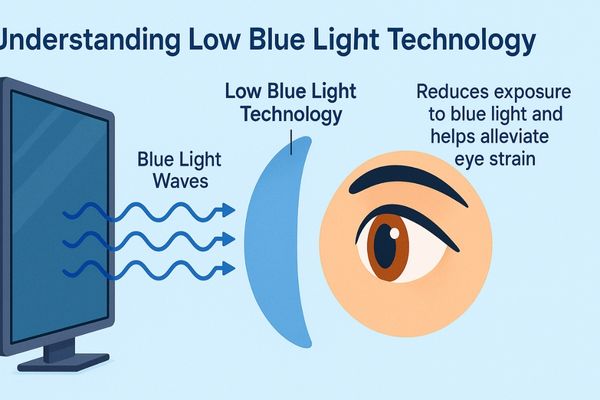
Digital eye strain is a significant occupational hazard for many medical professionals. The condition is caused by prolonged exposure to the high-energy visible (HEV) blue light emitted from digital displays. In response, monitor manufacturers have developed various technologies to reduce blue light exposure1. However, not all of these technologies are created equal, and their suitability varies greatly depending on the clinical application. Understanding the fundamental differences between these approaches is crucial for selecting a display that protects user well-being without compromising the diagnostic integrity of the image. We will now examine the most common methods for reducing blue light in medical displays2.
Hardware-Based Low Blue Light Reduces Eye Strain Without Color Shift
Reducing blue light often turns a screen yellow. This color distortion is unacceptable for diagnostics. A hardware solution solves this problem by changing the light at its source, preserving critical color accuracy.
Hardware low blue light technology adjusts the monitor’s LED backlight to shift the peak wavelength of blue light away from the most harmful range. This approach reduces eye strain without causing a noticeable color shift.
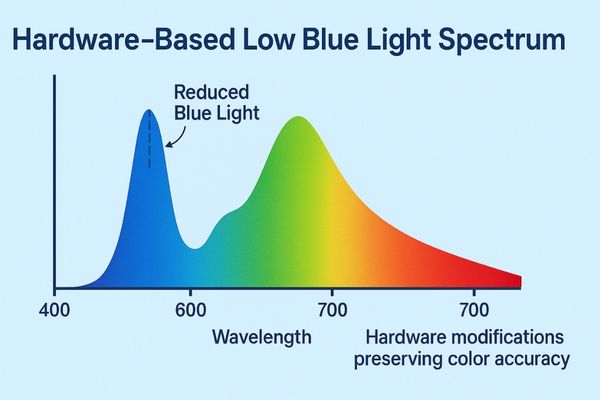
The most sophisticated method for reducing harmful blue light is to address it at the source: the LED backlight3. In a hardware-based solution, the display uses specially designed LEDs. The phosphor coating on these LEDs is engineered to emit less energy in the most harmful, high-energy 415-455 nm blue light spectrum. The system effectively shifts the peak energy to a slightly longer, less harmful wavelength. The key advantage of this approach is that it reduces harmful blue light without altering the display’s overall color balance. The screen’s white point remains clean and neutral, not tinted yellow or amber. This is critically important in clinical settings like pathology or dermatology, where subtle variations in tissue color are a key part of the diagnostic information. By preserving color fidelity4, monitors like the MD52GC provide crucial ergonomic benefits without forcing clinicians to compromise on diagnostic accuracy. This method offers permanent, always-on protection that is integrated directly into the core hardware.
| Technology | Mechanism | Impact on Color |
|---|---|---|
| Hardware Solution | Modifies the LED backlight’s spectrum at the source. | Minimal to no color shift. Maintains accuracy. |
| Software Solution | Reduces the blue channel’s output via algorithms. | Creates a visible warm (yellow/amber) tint. |
Software Filtering Solutions Offer Flexibility but May Alter Accuracy
You need a simple way to make screens easier on the eyes. Software filters offer this, but generic versions can distort the very image a clinician needs to interpret, creating a new clinical risk.
Software filters use algorithms to lower the intensity of the blue color channel. This method is flexible but almost always produces a warmer image tone, which may compromise color-critical diagnostic tasks.
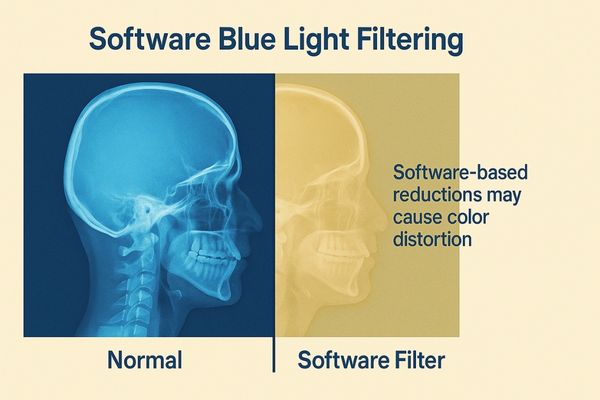
The most common and easily implemented form of blue light reduction5 is software-based filtering. This is the technology behind the "Night Mode" or "Eye Saver Mode" found on most consumer devices and operating systems. The software works by digitally altering the signal sent to the display panel. It simply instructs the monitor to show less blue in the final image by turning down the intensity of the blue color channel. While this is effective at reducing the total amount of blue light reaching the user’s eyes, it comes with a significant and unavoidable trade-off: color accuracy6. By reducing the blue component, the relative intensity of the red and green channels increases. This results in a noticeably warmer, yellowish image. For reading text or browsing the web, this is perfectly acceptable. In a medical context, however, it can be problematic. This color shift could alter the appearance of stained tissue on a pathology slide or mask subtle color variations in an endoscopic video, potentially impacting interpretation. Although flexible, software solutions must be used with caution on displays like the MD26C – 24" Diagnostic Monitor, especially when viewing color-dependent images.
Hybrid Approaches Balance Color Fidelity and User Comfort
You want both visual comfort and diagnostic accuracy. Choosing between pure hardware or pure software methods feels like an unnecessary compromise. A hybrid system offers a more balanced and practical solution.
Hybrid solutions combine a foundational hardware-level reduction of harmful blue light with user-selectable software modes. This balanced approach provides powerful eye strain relief while minimizing the impact on color fidelity.
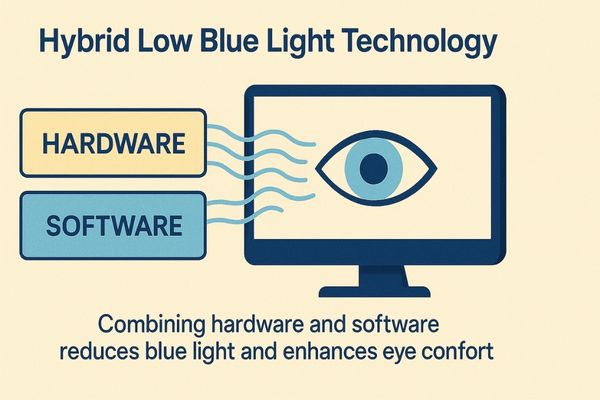
A hybrid approach seeks to provide the best of both worlds. These systems are built on a foundation of hardware-based low blue light technology. This means the display’s backlight is already optimized to reduce harmful blue light emissions7 without a major color shift. On top of this hardware foundation, the monitor includes specialized viewing modes that apply a fine-tuned, gentle software filter for specific tasks. For example, a "Reading Mode" might add a slight warming filter for comfort when reviewing text-heavy patient files, while the default "DICOM Mode8" would have no additional filtering to ensure maximum grayscale accuracy for diagnostic imaging. This gives the clinician direct control. They can choose a mode optimized for the specific task at hand, balancing comfort and accuracy as needed. This approach provides a greater total reduction in blue light than hardware alone, but with a far less dramatic color shift than a pure software solution. This versatility makes hybrid technology, found in advanced displays like the MD51CHY – 34" 5MP Diagnostic Monitor for X-ray Imaging, an excellent choice for multi-purpose clinical workstations.
Impact of Low Blue Light on Long Reading Sessions in Radiology
Radiologists spend countless hours in dark rooms focused on screens. This intense, prolonged work leads to significant eye fatigue. Low blue light technology is a direct countermeasure to this unavoidable occupational hazard.
In radiology, where professionals view mainly grayscale images for hours, low blue light technology reduces visual fatigue. By cutting exposure to high-energy light, it improves sustained focus and diagnostic performance.

The radiology reading room presents a unique ergonomic challenge. Radiologists work in low ambient light to maximize perceived image contrast, making the monitor the dominant light source. They perform this visually demanding work for hours at a time, which leads to a high incidence of digital eye strain9. While color accuracy might seem less important for grayscale imaging, high-energy blue light still has a physical impact. Blue light scatters more within the eye’s vitreous humor, a phenomenon that can reduce perceived image sharpness and contribute to fatigue. By using a display with low blue light technology10, the amount of this high-energy light is reduced. This can lead to a more comfortable viewing experience, with less reported fatigue and dryness. Improving comfort is not just a matter of convenience; it is about maintaining high levels of diagnostic performance throughout a long shift. A less fatigued radiologist is a more focused and effective radiologist. This makes the feature critical for displays like the MD52G – 5MP Grayscale Mammography Monitor, where sustained concentration is absolutely paramount.
| Viewing Condition | Primary Challenge | Low Blue Light Benefit |
|---|---|---|
| Dark Reading Room | High screen-to-ambient light contrast. | Reduces direct eye strain and physical fatigue. |
| Bright Operating Room | High ambient light washes out screen. | Provides comfort for secondary or peripheral displays. |
| Standard Office Lighting | Mixed lighting sources and screen glare. | Minimizes cumulative daily blue light exposure. |
Certification Standards Validate Low Blue Light Performance
Every manufacturer claims their display is easy on the eyes. How can you verify these marketing claims? Independent, third-party certifications provide the objective proof needed for confident decision-making.
Certifications from independent testing bodies like TÜV Rheinland provide quantitative validation of a monitor’s low blue light performance. These standards offer a reliable and trustworthy benchmark for hospital procurement teams.
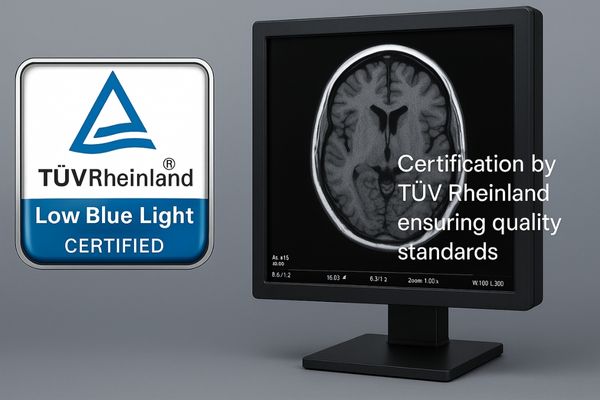
With so many different technologies and marketing terms on the market, it can be difficult for a buyer to distinguish between effective solutions and simple buzzwords. This is where third-party certification standards become invaluable. Organizations like TÜV Rheinland are internationally recognized, independent bodies that test and validate product claims. For low blue light technology11, they perform a series of quantitative tests. They use specialized equipment to measure the exact spectral output of the display, determining precisely how much the harmful blue light has been reduced or shifted. They also test for screen flicker, as imperceptible flicker is another major cause of eye strain. When a display earns a certification like "TÜV Rheinland Low Blue Light (Hardware Solution)12," it provides objective proof that the monitor meets a stringent set of criteria for visual comfort and safety. For hospital procurement departments, these certifications simplify the purchasing process. They can specify a required certification in their tender documents, ensuring all proposed products meet a verified standard of quality, as seen in devices like the MS275P – 27" 4K Surgical Monitor.
Conclusion
Understanding the differences between hardware, software, and hybrid low blue light systems is essential. Seeking third-party certification guarantees a display will provide both diagnostic integrity and genuine user well-being.
📧 Want expert advice on selecting certified low blue light medical displays? Contact Martin at martin@reshinmonitors.com to explore Reshin’s advanced solutions.
-
Explore this link to learn effective strategies for minimizing blue light exposure, crucial for eye health and comfort. ↩
-
This resource will guide you in selecting medical displays that balance user well-being and diagnostic accuracy. ↩
-
Explore how LED backlight technology enhances display quality and reduces harmful blue light exposure. ↩
-
Learn about the significance of color fidelity in diagnostics and how it impacts clinical accuracy. ↩
-
Explore this link to understand various effective methods for reducing blue light exposure and their implications. ↩
-
Learn why maintaining color accuracy is crucial in medical imaging to ensure proper diagnosis and interpretation. ↩
-
Understanding blue light emissions is crucial for eye health and can help you make informed decisions about screen time. ↩
-
Exploring DICOM Mode will enhance your knowledge of diagnostic imaging standards, essential for healthcare professionals. ↩
-
Understanding digital eye strain can help radiologists mitigate its effects and enhance their work performance. ↩
-
Exploring low blue light technology can reveal its advantages in reducing eye fatigue, crucial for professionals in visually demanding fields. ↩
-
Discover the advantages of low blue light technology and its impact on reducing eye strain and improving visual comfort. ↩
-
Explore this link to understand the significance of TÜV Rheinland certification in ensuring visual comfort and safety for displays. ↩

